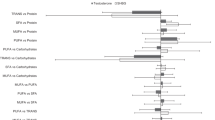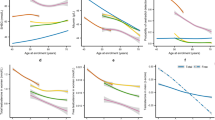Abstract
Background/Objectives:
Little is known about nutritional factors that influence circulating concentrations of steroid hormones, which are consistently associated with risk of breast cancer for postmenopausal women. We aimed to investigate the association between consumption of animal products and the plasma concentrations of steroid hormones and sex hormone-binding globulin (SHBG).
Subjects/Methods:
Cross-sectional analysis was conducted on plasma from 766 naturally postmenopausal women. We measured plasma concentrations of steroid hormones and SHBG, and estimated dietary intakes using a 121-item food frequency questionnaire. Log-transformed values of hormone concentrations were regressed on quartiles of intake of meat and dairy products among food items, and fats, proteins and cholesterol among nutrient intake.
Results:
Total red and fresh red meat consumption was negatively associated with SHBG levels (P for trend=0.04 and <0.01, respectively). Mean SHBG concentrations were ∼8% and 13% lower for women in the highest quartile compared with the lowest quartile of total red and fresh red meat consumption, respectively. Positive associations were observed between dairy product consumption and total and free estradiol concentrations (P for trend=0.02 and 0.03, respectively). Mean concentrations of total and free estradiol were 15 and 14% higher for women in the highest quartile of dairy product consumption than for those in the lowest quartile, respectively. No associations were observed with consumption of processed meat, chicken, fish, eggs, cholesterol, fats or protein.
Conclusions:
Our study suggests that greater consumption of total red and fresh red meat and dairy products might influence circulating concentrations of SHBG and estradiol, respectively. Confirmation and further investigation is required.
This is a preview of subscription content, access via your institution
Access options
Subscribe to this journal
Receive 12 print issues and online access
$259.00 per year
only $21.58 per issue
Buy this article
- Purchase on Springer Link
- Instant access to full article PDF
Prices may be subject to local taxes which are calculated during checkout
Similar content being viewed by others
References
Adlercreutz H, Hamalainen E, Gorbach SL, Goldin BR, Woods MN, Dwyer JT (1989). Diet and plasma androgens in postmenopausal vegetarian and omnivorous women and postmenopausal women with breast cancer. Am J Clin Nutr 49, 433–442.
Andersson AM, Skakkebaek NE (1999). Exposure to exogenous estrogens in food: possible impact on human development and health. Euro J Endocrinol 140, 477–485.
Armstrong BK, Brown JB, Clarke HT, Crooke DK, Hahnel R, Masarei JR et al. (1981). Diet and reproductive hormones: a study of vegetarian and nonvegetarian postmenopausal women. J Natl Cancer Inst 67, 761–767.
Barbosa JC, Shultz TD, Filley SJ, Nieman DC (1990). The relationship among adiposity, diet, and hormone concentrations in vegetarian and nonvegetarian postmenopausal women. Am J Clin Nutr 51, 798–803.
Boyd NF, Martin LJ, Beaton M, Cousins M, Kriukov V (1996). Long-term effects of participation in a randomized trial of a low-fat, high-carbohydrate diet. Cancer Epidemiol Biomarkers Prev 5, 217–222.
Carruba G, Granata OM, Pala V, Campisi I, Agostara B, Cusimano R et al. (2006). A traditional Mediterranean diet decreases endogenous estrogens in healthy postmenopausal women. Nutr Cancer 56, 253–259.
Endogenous Hormones Breast Cancer Collaborative Group (2003). Free estradiol and breast cancer risk in postmenopausal women: comparison of measured and calculated values. Cancer Epidemiol Biomarkers Prev 12, 1457–1461.
English DR, MacInnis RJ, Hodge AM, Hopper JL, Haydon AM, Giles GG (2004). Red meat, chicken, and fish consumption and risk of colorectal cancer. Cancer Epidemiol Biomarkers Prev 13, 1509–1514.
Fontana L, Klein S, Holloszy JO (2006). Long-term low-protein, low-calorie diet and endurance exercise modulate metabolic factors associated with cancer risk. Am J Clin Nutr 84, 1456–1462.
Fritsche S, Steinhart H (1998). Differences in natural steroid hormone patterns of beef from bulls and steers. J Anim Sci 76, 1621–1625.
Fung TT, Hu FB, Barbieri RL, Willett WC, Hankinson SE (2007). Dietary patterns, the Alternate Healthy Eating Index and plasma sex hormone concentrations in postmenopausal women. Int J Cancer 121, 803–809.
Ganmaa D, Sato A (2005). The possible role of female sex hormones in milk from pregnant cows in the development of breast, ovarian and corpus uteri cancers. Med Hypotheses 65, 1028–1037.
Giles GG, English DR (2002). The Melbourne Collaborative Cohort Study. IARC Sci Publ 156, 69–70.
Hartmann SLM, Steinhart H (1998). Natural Occurrence of steroid hormones in food. Food Chem 62, 7–20.
Hodge A, Patterson AJ, Brown WJ, Ireland P, Giles G (2000). The Anti Cancer Council of Victoria FFQ: relative validity of nutrient intakes compared with weighed food records in young to middle-aged women in a study of iron supplementation. Aust NZ J Public Health 24, 576–583.
Holmes MD, Spiegelman D, Willett WC, Manson JE, Hunter DJ, Barbieri RL et al. (2000). Dietary fat intake and endogenous sex steroid hormone levels in postmenopausal women. J Clin Oncol 18, 3668–3676.
Ingram DM, Bennett FC, Willcox D, de Klerk N (1987). Effect of low-fat diet on female sex hormone levels. J Natl Cancer Inst 79, 1225–1229.
Ireland P, Jolley D, Giles G, O'Dea K, Powles J, Rutishauser I et al. (1994). Development of the Melbourne FFQ: a food frequency questionnaire for use in an Australian prospective study involving an ethnically diverse cohort. Asia Pacific J Clin Nutr 3, 19–31.
Jacques H, Noreau L, Moorjani S (1992). Effects on plasma lipoproteins and endogenous sex hormones of substituting lean white fish for other animal-protein sources in diets of postmenopausal women. Am J Clin Nutr 55, 896–901.
Kaaks R, Bellati C, Venturelli E, Rinaldi S, Secreto G, Biessy C et al. (2003). Effects of dietary intervention on IGF-I and IGF-binding proteins, and related alterations in sex steroid metabolism: the Diet and Androgens (DIANA) Randomised Trial. Euro J Clin Nutr 57, 1079–1088.
Kabir M, Skurnik G, Naour N, Pechtner V, Meugnier E, Rome S et al. (2007). Treatment for 2 mo with n 3 polyunsaturated fatty acids reduces adiposity and some atherogenic factors but does not improve insulin sensitivity in women with type 2 diabetes: a randomized controlled study. Am J Clin Nutr 86, 1670–1679.
Larsson SC, Bergkvist L, Rutegard J, Giovannucci E, Wolk A (2006). Calcium and dairy food intakes are inversely associated with colorectal cancer risk in the Cohort of Swedish Men. Am J Clin Nutr 83, 667–673. quiz 728-669.
Lewis J, Milligan G, Hunt A (1995). NUTTAB95 Nutrient Data Table for Use in Australia. Australian Government Publishing Service: Canberra.
Li XM, Ganmaa D, Sato A (2003). The experience of Japan as a clue to the etiology of breast and ovarian cancers: relationship between death from both malignancies and dietary practices. Med Hypotheses 60, 268–275.
Lucenteforte E, Talamini R, Montella M, Dal Maso L, Tavani A, Deandrea S et al. (2008). Macronutrients, fatty acids and cholesterol intake and endometrial cancer. Ann Oncol 19, 168–172.
Lukanova A, Lundin E, Akhmedkhanov A, Micheli A, Rinaldi S, Zeleniuch-Jacquotte A et al. (2003). Circulating levels of sex steroid hormones and risk of ovarian cancer. Int J Cancer 104, 636–642.
Macinnis RJ, English DR, Gertig DM, Hopper JL, Giles GG (2004). Body size and composition and risk of postmenopausal breast cancer. Cancer Epidemiol Biomarkers Prev 13, 2117–2125.
Nagata C, Nagao Y, Shibuya C, Kashiki Y, Shimizu H (2005). Fat intake is associated with serum estrogen and androgen concentrations in postmenopausal Japanese women. J Nutr 135, 2862–2865.
Prentice R, Thompson D, Clifford C, Gorbach S, Goldin B, Byar D (1990). Dietary fat reduction and plasma estradiol concentration in healthy postmenopausal women. The Women's Health Trial Study Group. J Natl Cancer Inst 82, 129–134.
Rock CL, Flatt SW, Laughlin GA, Gold EB, Thomson CA, Natarajan L et al. (2008). Reproductive steroid hormones and recurrence-free survival in women with a history of breast cancer. Cancer Epidemiol Biomarkers Prev 17, 614–620.
Sodergard R, Backstrom T, Shanbhag V, Carstensen H (1982). Calculation of free and bound fractions of testosterone and estradiol-17 beta to human plasma proteins at body temperature. J Steroid Biochem 16, 801–810.
Taylor EF, Burley VJ, Greenwood DC, Cade JE (2007). Meat consumption and risk of breast cancer in the UK Women's Cohort Study. Br J Cancer 96, 1139–1146.
Thomas HV, Davey GK, Key TJ (1999). Oestradiol and sex hormone-binding globulin in premenopausal and post-menopausal meat-eaters, vegetarians and vegans. Br J Cancer 80, 1470–1475.
Willett WC (1998). Nutritional Epidemiology 2nd edn Oxford University Press: New York.
Wu AH, Yu MC, Tseng CC, Stanczyk FZ, Pike MC (2009). Dietary patterns and breast cancer risk in Asian American women. Am J Clin Nutr 89, 1145–1154.
Acknowledgements
Recruitment of the cohort was funded by the VicHealth and The Cancer Council Victoria. This study was funded by grants from the National Health and Medical Research Council (251533, 209057) and the National Breast Cancer Foundation, and was further supported by the infrastructure provided by The Cancer Council Victoria.
This study was made possible by the contribution of many people, including the original investigators and the diligent team who recruited the participants and who continue working on follow-up. We would like to express our gratitude to the many thousands of Melbourne residents who continue to participate in the study. We also acknowledge the contribution of Ms Sonia Dunn for assistance with the hormone measurements.
Author information
Authors and Affiliations
Corresponding author
Additional information
Contributors: MTB, LB and KK wrote the manuscript, MTB, LB and KK were involved in study design, HAM conducted laboratory analysis of samples for hormone measures, LB and KK performed statistical analysis, and all authors contributed to the interpretation of results and review of the manuscript.
Rights and permissions
About this article
Cite this article
Brinkman, M., Baglietto, L., Krishnan, K. et al. Consumption of animal products, their nutrient components and postmenopausal circulating steroid hormone concentrations. Eur J Clin Nutr 64, 176–183 (2010). https://doi.org/10.1038/ejcn.2009.129
Received:
Revised:
Accepted:
Published:
Issue Date:
DOI: https://doi.org/10.1038/ejcn.2009.129
Keywords
This article is cited by
-
Food groups and nutrients consumption and risk of endometriosis: a systematic review and meta-analysis of observational studies
Nutrition Journal (2022)
-
Pre- and post-diagnostic intake of whole grain and dairy products and breast cancer prognosis: the Danish Diet, Cancer and Health cohort
Breast Cancer Research and Treatment (2020)
-
Racial disparities in red meat and poultry intake and breast cancer risk
Cancer Causes & Control (2013)
-
A dietary pattern derived to correlate with estrogens and risk of postmenopausal breast cancer
Breast Cancer Research and Treatment (2012)



